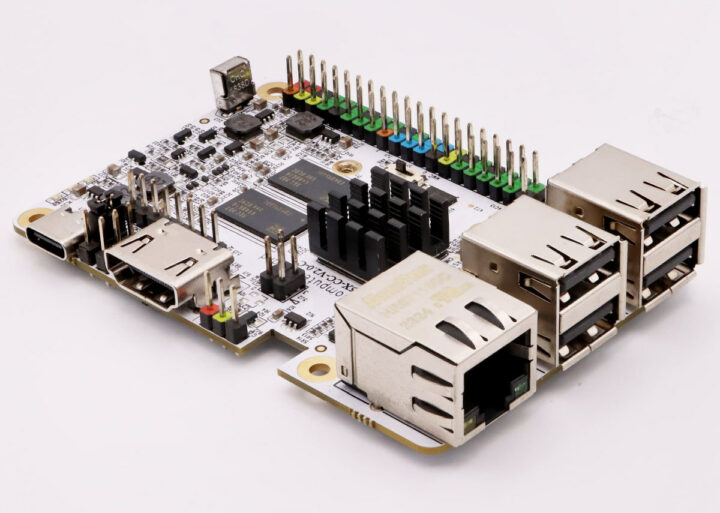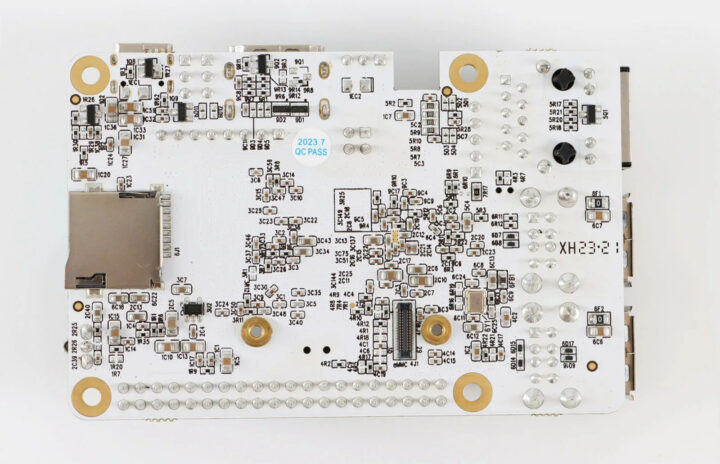Libre Computer AML-S905X-CC-V2 “Sweet Potato” is a “new” Amlogic S905X SBC following the Raspberry Pi 3B form factor and that will eventually directly boot Linux images downloaded from the Internet using the Libre Computer OS Tool (LOST).
I wrote “new” in quotes because the single board computer is an update to the Potato board (AML-S905X-CC) introduced in 2017 with just a few hardware changes. But that’s because Libre Computer focuses on the software side and all/most of their boards can now run mainline Linux and have support for features such as LOST whose support is set to be implemented by November.
Libre Computer AML-S905X-CC-V2 SBC specifications with changes in bold or strikethrough:
- SoC – Amlogic S905X quad-core Arm Cortex-A53 processor @ 1.5 GHz with penta-core Arm Mali-450MP GPU, and Amlogic Video Engine 10 VPU
- System Memory – 2GB DDR4 (OEM can request 1GB)
- Storage
- 1x microSD card slot with UHS SDR104 support
- eMMC 5.x slim module connector
- 16MB SPI flash with boot select switch
- Video Output – HDMI 2.0 port,
3.5mm TRRS “AV” jack with CVBS (480i / 576i) - Audio Output – HDMI,
AV jack (stereo audio), SPDIF output header, and I2S header - Connectivity – 10/100M Ethernet with optional PoE support
- USB – 4x USB 2.0 host ports, USB 2.0 header
- Expansion
- ADC + I2S Header
- 40-pin Raspberry Pi header with I2C, SPI, PWM, 5V, 3.3V, and GPIO
- Debugging – UART via header for access to the serial console
- Misc – IR Receiver, onboard jumper for HDMI CEC or GPIO 11 selection, status LEDs,\
- Power Supply
- 5V/3A via USB Type-C port
- PoE header
- Dimensions – Raspberry Pi 3 form factor
The new revision of the board loses CVBS video composite and analog audio output but gains PoE support, a USB header, and a 16MB SPI flash. The memory has been changed from DDR3 to DDR4 with negligible performance differences, and a USB-C port replaced the legacy micro USB port for power.
The actual board design was completed in 2020, but as noted in the introduction, Libre Computer differentiates itself from other SBC vendors and does not release new hardware every month or so like like Orange Pi and others, but mostly focuses its efforts on software. In practice that means mainline Linux support, standardized boot with UEFI support meaning ARM64 EBBR/SystemReady image should boot on the board, and well as support for Libre Computer OS Tool (LOST) to easily download and install Linux images from the Internet to the board’s storage (MicroSD, eMMC, USB, NVMe) in a way similar to Khadas OOWOW system. You’ll find a 3-year old demo of LOST showing how to install CoreElec on the AML-S905X-CC board.
Libre Computer AML-S905X-CC-V2 SBC can be purchased for $35 on Amazon, Aliexpress, or LoverPi. Further details may also be found in the announcement on Libre Computer Hin where more documentation should eventually become available.
Thanks to Geoffrey for the tip

Jean-Luc started CNX Software in 2010 as a part-time endeavor, before quitting his job as a software engineering manager, and starting to write daily news, and reviews full time later in 2011.
Support CNX Software! Donate via cryptocurrencies, become a Patron on Patreon, or purchase goods on Amazon or Aliexpress. We also use affiliate links in articles to earn commissions if you make a purchase after clicking on those links.








Just a small correction. Firmware with LOST is not due out until late October/early November timeframe.
Noted. I’ve updated the post to reflect that. When I chatted with LoveRPi last July I was told
I could also see the new board in the GitHub repo today:
So I just assumed it was already implemented.
Strange, there site doesn’t have the board on it?
Yes, I’ve noticed this. Maybe they’ll update it later or libre.computer is not updated anymore?
They’ve been making announcements on X/twitter and on their forum. I don’t know why they haven’t updated their website, but the current list of products was posted at https://hub.libre.computer/t/libre-computer-board-model-differences-and-optimal-applications-to-run/2864
I don’t think the cottonwood boards have been released yet.
Yes, that’s why I’m patiently waiting before writing about it 🙂
Ran across that site today too. Very interesting. Says what the cpus are in the upcoming, usually allwinner. Most of the new models have bios/system ready which will really simplify like sweet potato. I do see sweet potato lacks audio jack, which isn’t in the specs list above JL, but you can see in photo it doesn’t have it. This board more for industry use and looks quite good for it too.
They used to have this really cool sheet metal heatsink enclosure. Looks like it got discontinued b/c I don’t see it anymore 🙁
I remember getting this for 5-10 USD on the kickstarter. Great little board and their company mission is fantastic. Focusing on mainlining and support and not the latest chips.
Hope they keep iterating on this design. Maybe make it low-power and battery compatible next or something. I don’t know if the S905X is appropriate to do arduino-like stuff like deep sleep, wake up on pin input
This still exists. https://www.loverpi.com/collections/la-frite
Oh sorry! I got the Frite and Potato mixed up :))
Any plans to update the Frite?
And is the mainline support more or less identical between the two boards? or is one ahead of the other? (a little unclear on where to find info). It seem the Frite is only mildly less powerful – but more compact and cheaper
Oh and do you have a Taobao store?
I rather like these things, and the company. Thank you for making something that works, at a good price, instead of chasing the latest chip. SBC space is awash with boards that don’t meet one (or both) of those. I bought one for my brother as a gift – hasn’t quite figured out what to do with it, but it got working without too much trouble.
With a 100 Mbit Ethernet this is really a potato board.
Is this S905X4 ?
No, they kept the same processor as in the first version of the board. That’s one of the consequence running mainline code, as it takes time to port the software.